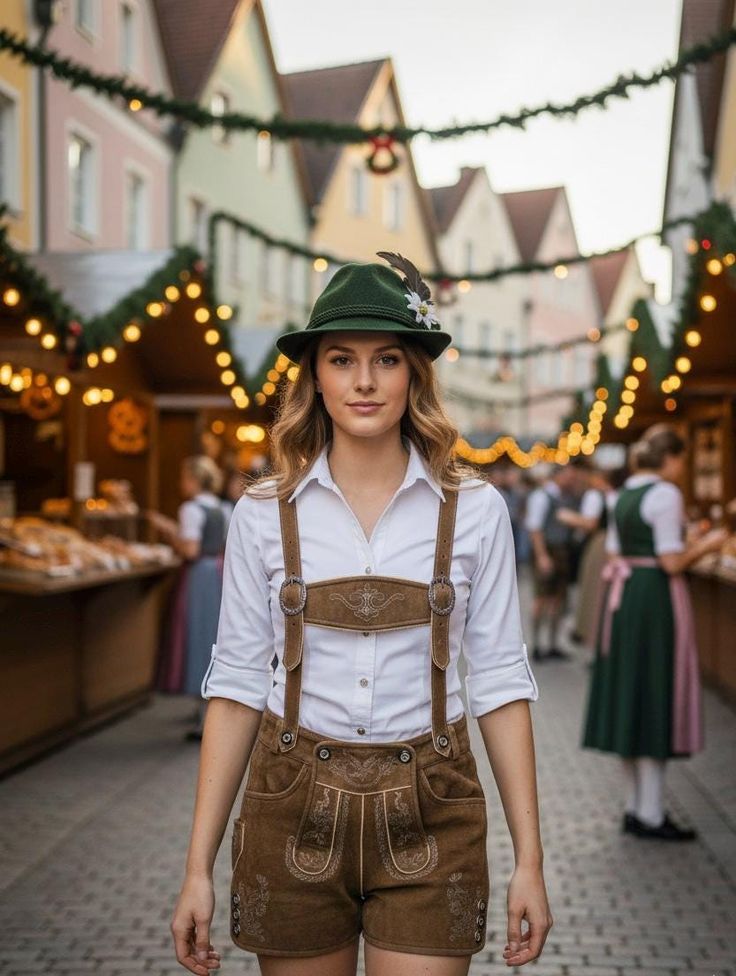In the heart of Bavaria, among the sounds of oompah bands, the aroma of roasted almonds, and the cheer of Oktoberfest crowds, one outfit has become an icon of Alpine culture — the lederhosen. Traditionally seen as the uniform of rugged Alpine men, lederhosen were designed for work, hunting, and festival wear. But today, the spotlight has shifted. A growing number of women are proudly donning women’s lederhosen — redefining tradition and bringing a fresh, powerful energy to this age-old attire.
In this article, we’ll explore the history, meaning, styles, and modern appeal of women’s lederhosen — and why they’ve become a global fashion statement that blends heritage with confidence.
1. What Are Lederhosen? A Brief History
Lederhosen, literally translating to “leather trousers,” originated in the Alpine regions of Germany, Austria, and Switzerland. Made from durable deer, goat, or cowhide, they were initially crafted as workwear for farmers and hunters who needed clothing tough enough to withstand physical labor and harsh outdoor conditions.
Over time, lederhosen evolved from practical workwear to festive attire, symbolizing regional pride. By the 19th century, they became a cornerstone of Bavarian folk culture and traditional celebrations such as Oktoberfest. Paired with embroidered suspenders, rustic shirts, and wool socks, lederhosen became an unmistakable part of Central European heritage.
But for centuries, lederhosen were considered men’s clothing. Women typically wore dirndls — the feminine counterpart with fitted bodices and flowing skirts. That’s no longer the case.
2. The Rise of Women’s Lederhosen: Breaking Tradition
The evolution of women’s lederhosen is a story of both fashion and empowerment. As traditional clothing experienced a modern revival, women began embracing lederhosen not only for their rugged charm but also as a symbol of equality and individuality.
In the late 20th century, as women took on more visible roles in culture, fashion, and festivals, designers began crafting lederhosen specifically for female forms. They featured softer leather, slimmer fits, and tailored cuts that emphasized comfort and style while retaining authenticity.
By the 2000s, women’s lederhosen became a hit at Oktoberfest and folk festivals around the world. Women were no longer limited to dirndls; they could now express their Bavarian pride in a way that matched their personality — bold, independent, and modern.
3. Design and Features of Women’s Lederhosen
Women’s lederhosen blend traditional craftsmanship with contemporary aesthetics. Though they preserve many of the same materials and details as men’s versions, subtle differences make them unique.
a. Materials
Genuine women’s lederhosen are crafted from high-quality leather, often suede or nubuck, chosen for softness and flexibility. Cowhide offers a sturdy, traditional look, while goat leather provides a more supple and feminine texture.
b. Fit and Length
While men’s lederhosen typically fall at or below the knee, women’s styles come in a variety of lengths:
- Short Lederhosen – These end mid-thigh, adding a modern, playful twist.
- Knee-Length Lederhosen – Ideal for traditional festivals and cooler weather.
- High-Waisted Lederhosen – Offer a vintage silhouette and flattering fit.
c. Embroidery and Detailing
One of the most distinguishing features of women’s lederhosen is the intricate embroidery. Floral patterns, edelweiss motifs, and Bavarian symbols are commonly stitched in bright threads, often complemented by decorative buttons and lace-up sides.
d. Color Variations
While classic shades like brown, tan, and black remain popular, modern designs come in bold colors such as olive, burgundy, navy, and even pastel hues. These color options allow for personalization while maintaining cultural integrity.
4. How to Style Women’s Lederhosen
Styling women’s lederhosen is all about balancing tradition with personality. Whether you’re attending Oktoberfest or adding a rustic twist to your streetwear, here’s how to get the look right.
a. The Classic Oktoberfest Look
- Pair your lederhosen with a white or plaid blouse — often off-the-shoulder or puff-sleeved for a feminine touch.
- Add traditional accessories such as suspenders, wool socks, and ankle boots or Haferl shoes.
- Complete the look with braided hair, a floral crown, or a small hat with feathers.
b. Casual Modern Style
Women’s lederhosen aren’t just for festivals. For a modern twist:
- Wear them with a graphic tee, leather jacket, or denim vest.
- Choose sneakers or combat boots for a streetwear-inspired edge.
- Add minimal jewelry and bold sunglasses for an effortless, chic appearance.
c. Evening or Event Wear
For special occasions, choose dark suede lederhosen with refined embroidery and pair them with a silk blouse or lace top. Heeled boots or sandals can elevate the look while maintaining its traditional charm.
5. Women’s Lederhosen vs. Dirndl: Which Should You Choose?
The choice between a dirndl and lederhosen often depends on personality and comfort. A dirndl is feminine, flowing, and romantic — ideal for those who prefer classic elegance. In contrast, lederhosen exude confidence, energy, and modernity.
Many women alternate between both. For example:
- On opening days or formal events, they might wear a dirndl.
- For casual gatherings or outdoor celebrations, lederhosen provide freedom and durability.
Ultimately, women’s lederhosen give you the power to celebrate tradition your way — strong, stylish, and comfortable.
6. Cultural Significance and Empowerment
Beyond fashion, women’s lederhosen carry a deeper message. They represent cultural evolution and gender equality — a bridge between tradition and modern expression.
Wearing lederhosen as a woman is a statement of pride and individuality. It challenges old norms that divided clothing by gender and celebrates the idea that anyone can embrace Bavarian heritage in their own style.
At Oktoberfest and regional festivals today, seeing women in lederhosen is completely natural. In fact, many fashion-conscious festivalgoers prefer them for comfort and practicality. You can dance, walk, and celebrate freely — without worrying about tight corsets or heavy skirts.
7. Tips for Buying the Perfect Pair of Women’s Lederhosen
Finding the right lederhosen is about quality, fit, and personality. Here’s what to keep in mind:
- Material Quality: Choose genuine leather for longevity and comfort. Synthetic options may be cheaper but lack breathability and authenticity.
- Proper Fit: Lederhosen should fit snugly but not restrict movement. Remember that leather stretches slightly over time.
- Embroidery & Details: Look for fine craftsmanship and sturdy stitching. Authentic embroidery enhances both durability and charm.
- Try Before Buying: If possible, try multiple sizes — especially if ordering from a new brand.
- Care Instructions: Keep them dry and clean. Use leather-safe cleaning products and store them properly to maintain texture and color.
8. Why Women’s Lederhosen Are a Global Trend
While lederhosen were once confined to Alpine regions, globalization and fashion media have turned them into an international phenomenon. From Oktoberfest events in Munich to beer festivals in the U.S., Australia, and Japan, women’s lederhosen have become a symbol of celebration and freedom.
Celebrities, models, and influencers often wear them to showcase individuality and cultural appreciation. Fashion designers, too, have begun integrating lederhosen-inspired elements into collections — blending rustic leather aesthetics with modern tailoring.
This trend underscores a global movement: embracing tradition while rewriting its rules.
9. Sustainability and Ethical Fashion
Another reason for the renewed popularity of women’s lederhosen is sustainability. Unlike fast fashion, high-quality lederhosen are made to last. When crafted from responsibly sourced leather and natural dyes, they embody a sustainable fashion philosophy — one that values craftsmanship over mass production.
Many contemporary artisans emphasize ethical sourcing, handmade detailing, and eco-friendly tanning methods, ensuring each piece tells a story not just of culture, but of conscious creation.
10. The Future of Women’s Lederhosen
As society moves toward gender-neutral and sustainable fashion, women’s lederhosen will continue to thrive. Their appeal lies in versatility — merging heritage with modern empowerment. The next generation of designers is already experimenting with vegan leather, bold embroidery, and cross-cultural influences, giving lederhosen a global identity.
For women everywhere, lederhosen are more than attire — they’re a statement. A reminder that strength and style can coexist. That tradition can evolve without losing its soul.
Conclusion
Women’s lederhosen stand at the crossroads of history and modernity — where rustic tradition meets fearless femininity. Once a symbol of masculine workwear, they now embody the freedom, confidence, and creativity of women around the world.
Whether you wear them to Oktoberfest, a local folk festival, or as part of a personal style statement, women’s lederhosen tell a story: one of strength, pride, and timeless elegance.

